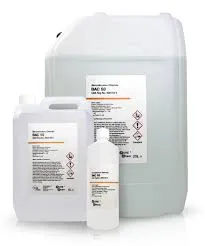chloro isothiazolinone
Understanding Chloroisothiazolinone Uses, Safety, and Regulations
Chloroisothiazolinone, a synthetic organic compound, has garnered attention for its biocidal properties and effectiveness as a preservative in various products. Primarily used in cosmetics, personal care items, and industrial applications, this compound plays a vital role in preventing microbial growth and extending shelf life. However, its use has raised concerns regarding safety and potential health risks, especially for those who are sensitive to preservatives.
Chemical Structure and Properties
Chloroisothiazolinone belongs to a group of compounds known as isothiazolinones. Its chemical structure consists of a five-membered ring containing nitrogen and sulfur atoms, with a chlorine substituent that contributes to its potent antimicrobial properties. The compound is typically used in combination with methylisothiazolinone, and together they form a powerful preservative system known for its effectiveness against bacteria, fungi, and algae.
Applications
This compound is widely utilized in various industries. In cosmetics and personal care products, chloroisothiazolinone is commonly found in shampoos, conditioners, lotions, and creams. Its ability to inhibit microbial growth ensures that products remain safe for use and effective over time.
In addition to personal care, chloroisothiazolinone is also employed in industrial applications, such as water treatment and the preservation of paints and coatings. Its efficacy in these applications is critical, as microbial contamination can significantly impact the performance and longevity of industrial products.
Safety and Health Concerns
chloro isothiazolinone

Despite its effectiveness, the use of chloroisothiazolinone has come under scrutiny due to safety concerns. Studies indicate that it may cause allergic reactions, particularly in individuals with sensitive skin. The most common reactions include contact dermatitis, which can result in redness, itching, and swelling of the affected area. These allergic reactions are more prevalent in products that contain higher concentrations of the compound.
To address these concerns, many regulatory authorities have implemented guidelines for the permissible concentration of chloroisothiazolinone in consumer products. For instance, the European Commission’s Scientific Committee on Consumer Safety (SCCS) has established specific limits for its use in cosmetics, emphasizing the need for labeling and consumer awareness.
Regulatory Measures
In Europe, chloroisothiazolinone is listed under the EU Cosmetic Products Regulation, which mandates safety assessments of cosmetic ingredients. Manufacturers are required to conduct extensive testing to ensure that their products do not pose a risk to consumers. Similarly, in the United States, the Food and Drug Administration (FDA) and the Environmental Protection Agency (EPA) monitor the use of biocides and preservatives, ensuring they meet safety standards before reaching the market.
In recent years, consumer demand for safer and more natural alternatives has prompted some manufacturers to reduce or eliminate the use of chloroisothiazolinone in their products. The rising popularity of preservative-free formulations reflects a shift towards minimizing exposure to potentially harmful chemicals. Consequently, many brands are reformulating their products to include milder preservatives or alternative methods of preservation, such as employing specific packaging techniques to reduce contamination.
Conclusion
Chloroisothiazolinone remains a critical compound in the preservation of a wide range of products, from cosmetics to industrial applications. While its effectiveness is widely recognized, safety concerns have prompted regulatory measures to mitigate risks associated with its use. Consumers are encouraged to be aware of the ingredients in their personal care products and to conduct research on potential allergies or sensitivities.
As the industry evolves, the balance between efficacy and safety will continue to be a significant focus. As consumer preferences shift towards safer and more natural options, the future of preservatives like chloroisothiazolinone may see changes in formulation and use. Ultimately, education and transparency will remain essential in guiding consumers towards informed choices while ensuring product safety and effectiveness remain uncompromised.
-
Dodecyldimethylbenzylammonium Chloride: High-Purity DisinfectantNewsAug.30,2025
-
2-Phosphonobutane-1,2,4-Tricarboxylic Acid: Scale & CorrosionNewsAug.29,2025
-
Premium Isothiazolinones | Broad-Spectrum Biocidal SolutionsNewsAug.28,2025
-
LK-319 Special Scale And Corrosion Inhibitor For Steel Plants: Advanced Solutions for Industrial Water SystemsNewsAug.22,2025
-
Flocculant Water Treatment: Essential Chemical Solutions for Purification ProcessesNewsAug.22,2025
-
Isothiazolinones: Versatile Microbial Control Agents for Industrial and Consumer ApplicationsNewsAug.22,2025





